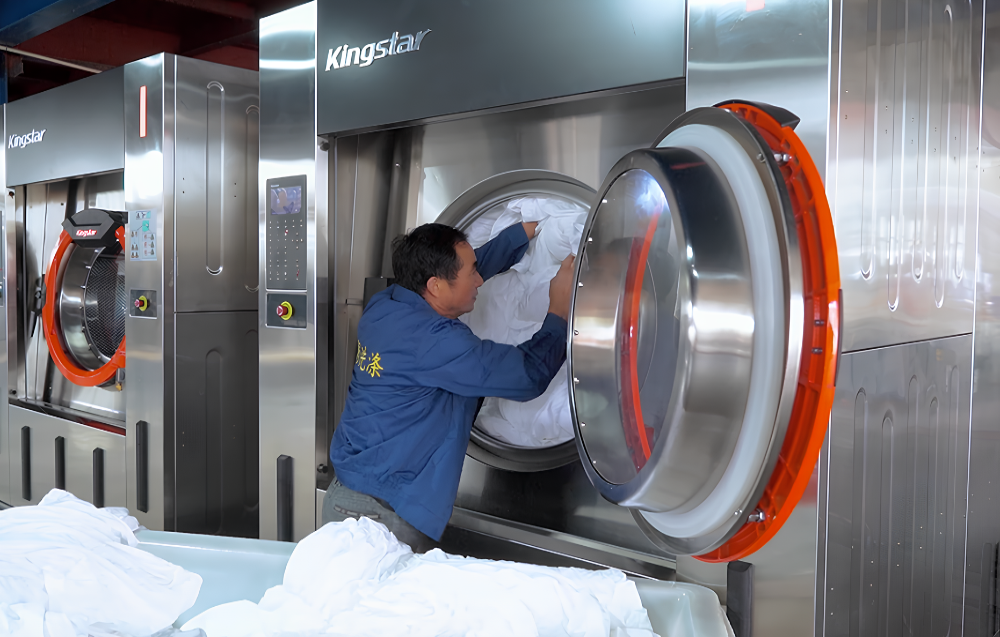
The Effect of Industrial Washer Extractors' Dehydration Rates on Drying Costs
Introduction
How much impact does the dehydration rate of industrial washer extractors have on the drying costs of laundry factories? Let’s discuss this issue today.
Understanding Dehydration G-Force
The dehydration rate of an industrial washer extractor is generally expressed as dehydration G-force, which depends on two factors: the diameter of the industrial washer extractor’s inner drum and the spin speed.
- ● The formula to calculate G-force is: G=n²×d÷1790
- ● d is the inner drum’s diameter and n is the spin speed.
Optimizing Dehydration Effect
Some laundry factories extend the dehydration time to improve the bad dehydration effect. However, the formula shows that the dehydration effect is not closely related to the dehydration time. If the high dehydration time has reached 6–8 minutes but the dehydration effect is still not ideal, then blindly increasing the number of dehydration times or extending the dehydration time will not have much effect.
High Dehydration Rates and Costs
High G-force means a high dehydration rate and low moisture content of linen after washing, decreasing the drying costs. Currently, the G-force of many industrial washer extractors on the market is between 260 G and 300 G. The maximum frequency of the inverter they use is generally between 116 Hz and 118 Hz.
Comparing Dehydration Performance
The maximum frequency of the Kingstar 100 kg industrial washer extractor inverter can reach 145 Hz. From this, we can calculate the dehydration G-force. The diameter of a Kingstar 100 kg industrial washer extractor’s inner drum is 1.31 meters. The dehydration rate is 745 rpm. So G=745²×1.31÷1790=406.
- ● After being dehydrated by a Kingstar 100 kg industrial washer extractor, the moisture content of towels is about 55%, while that of a 300 G industrial washer extractor is about 75%.
Cost Analysis for a Medium-Sized Chinese Laundry Factory
In a medium-sized Chinese laundry factory that washes 2,000 sets of clothes per day, what is the difference in steam cost between using a Kingstar 400G industrial washer extractor and an ordinary 300G industrial washer extractor?
A dryer consumes 3 kilograms of steam to evaporate 1 kilogram of water. An ironer consumes 1.2 kilograms to evaporate 1 kilogram of water. Every set of linen weighs 3.5 kilograms, and the proportion of towels is 35%.
Daily Operations
- ● Number of Clothes Washed: 2,000 sets
- ● Towel Weight Proportion: 35%
- ● Total Towel Weight: 2,000 × 3.5 kg × 35% = 2,450 kg
Additional Steam Consumption
- ● Normal Dehydration Effect: 20% higher moisture content
- ● Extra Steam Required for Towels: 2450×20%×3=1470 kg
Additional Steam for Bed Sheets, Quilt Covers, and Pillowcases
- ● Total Weight of Bed Sheets, Quilt Covers, and Pillowcases: 2000×3.5×65%=4550kg
- ● Additional Steam: 4550×20%×1.2=1092kg
Total Additional Steam Consumption Per Day:
Yearly Additional Steam Consumption:
Cost Implications
- ● Average Steam Cost in China: 280 RMB/ton
- ● Additional Annual Cost: 935.13 tons × 280 RMB/ton = 262,000 RMB
Additional Considerations
In addition, the low dehydration rate of industrial washers and the high moisture content of bed sheets and quilt covers contribute to more steam consumption and lower ironing speed. In this case, doing the same ironing work will require longer working time. Even some laundry factories with chest ironers need the pre-drying process of bed sheets and quilt covers so that they can iron the linen, which greatly reduces the working efficiency of the laundry factories.
ADD:No.388 Xinggang Road, Chongchuan District, Nantong City, 226000, Jiangsu Province, China.
-
Phone: +86-13917089379
-
Tel:+86-13917089379
-
Fax:+86-0513-85663366
-
E-mail:[email protected]









